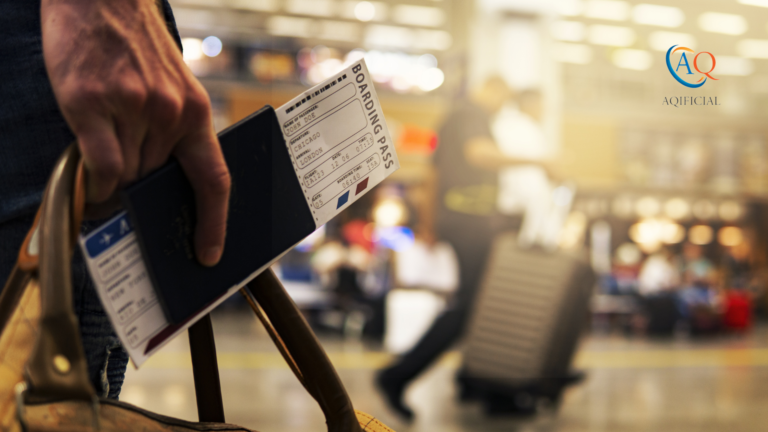Most frequent flyers who regularly travel through connected flights to reach their destination are well-aware of MCT or Minimum Connecting Time. However, if it’s your first time flying between two destinations through connected flights and with one or even more layovers in between, we recommend that you at least have a basic understanding of minimum connecting time or MCT.
This is because not being aware of its severity can greatly impact your flight plans, causing an unnecessary and otherwise avoidable delay in reaching your destination on time. And not to mention about the risk of not just missing your flight but also the money spent on it. This is because airlines in such scenarios aren’t always responsible and hence have no compensation policies.
This article explains what minimum connecting time (MCT) is, how it functions, the factors on which it depends, and its impact on passengers.
What is Minimum Connecting Time or MCT?
In aviation, minimum connecting time or MCT is the minimum stopover time needed for a passenger and their luggage to deboard an airplane that has just landed and board another airplane along with successful luggage transfer to that plane that is nearing its takeoff time.
This usually is the case when there are stopovers between connected flights. And while it may sound simple, this isn’t true. This is because missing a connected flight at a stopover location could significantly impact a traveler.
For instance, a person has multiple stopovers or connected flights to take before boarding the last flight flying to his/her destination.
In this case, if such a person misses just one connected flight in between, ultimately his/her overall travel route and all connected flight plans will suffer.
Minimum connecting time or MCT is also referred to as minimum connection time, minimum layover time, and legal connection time.
Understanding MCT is crucial for planning your layovers and ensuring a smooth travel experience
Examples to understand how minimum connecting time (MCT) works
To better understand how minimum connecting time (MCT) functions, let us explain to you this with the help of two situations.
Situation # 1 of minimum connecting time (MCT)
Flying on Qatar Airways.
Suppose that a person books a flight from Dubai to New York via a Qatar Airways ticket and has a stopover at Doha in between.
In this situation, Qatar Airways schedules your flight in a way that for some reason your flight gets delayed in Dubai hence it arrives late at Doha Airport, and consequently, you miss the connecting flight from Doha to New York.
In this case, Qatar Airways is responsible for arranging another flight from Doha to New York as soon as possible. Moreover, if the next scheduled flight is after a considerable gap, Qatar Airways is also responsible for accommodating you.
This means providing you with food, and a place to stay for the time being.
The average minimum connecting time (MCT) in such cases is usually less than 3 hours.
However, the advantage of having a connecting flight via a single ticket is that the airline is responsible for transferring your luggage between the airplanes so that you can easily switch between the flights without having to worry about it.
Situation # 2 of minimum connecting time (MCT)
Suppose that you again have to travel from Dubai to New York with a stopover at the Doha Airport. However, this time instead of having one ticket and a single connecting flight, you buy two tickets from different airlines.
For instance, you bought one Emirates Airline ticket for flying from Dubai to Doha. As for the other, you booked a Qatar Airways ticket for flying from Doha to New York.
How things differ in this situation from the first is explained below –
- Firstly, Emirates Airlines isn’t aware that any landing passengers including yourself has booked another plane ticket as a connecting flight from Doha to New York.
- Similarly, neither does Qatar Airways know that any passengers including you on their soon-to-take-off flight from Doha to New York are using Doha as a stopover and have just arrived via a flight from Dubai.
- Considering the above two factors, each airline won’t try to facilitate you during rush hour or if you are getting late and are on the verge of missing your next flight.
- Moreover, you also have to worry about getting off the landing flight at Doha Airport, collecting your luggage, then running for checking in for the next flight, submitting your luggage, and boarding the next flight.
And while airlines do their best to operate all flights on time, there is still a possibility that the flight from Dubai reaches Doha late.
Consequently, if you miss your next flight as a result, no airline can be held responsible, nor will they accept any responsibility.
The reason why you miss your connecting flight is because of the difference between landing late at Doha Airport and the minimum connecting time (MCT) in Doha.
Factors that affect the minimum connecting time (MCT)
Remember that every airport in the world has a predetermined minimum connecting time (MCT) to tackle the situations explained above. Note that it is the airports that set their own MCT and not the airlines.
There are several factors that airports consider while setting their MCT or minimum connecting time. These include –
- Airports primarily assume that the incoming flights will be on time. However, since a delay is always possible, they do consider the average delayed arrival time for determining MCT.
- Considering the airport layout. For instance, the distance between arrival and departure terminals at the airport. This helps estimate the time a passenger may take to travel from one point to another.
- What are the security arrangements at the airport? Do all passengers have to go through the same security and check-in protocols? Or are there any exceptions for those having connected flights?
- Understanding different sets of combinations between domestic-to-domestic travel, domestic-to-international travel, and international-to-international.
Factors that aren’t considered or cannot be considered for determining the MCT
Besides the above factors, there are a few factors that although important cannot be taken into account. This can be because of the very technical nature of such factors and parameters involved. These include –
- Not knowing where the passengers for the next connected flight are sitting in their previous flight and how long it will take them to get off the incoming flight.
- Overall rush at the airport or extraordinary rush at security clearance points around the airport.
What Determines Minimum connecting time (MCT)?
MCT is determined by a number of factors, including:
- The airport: Some airports have more efficient layouts and shorter distances between gates, which can result in shorter MCTs.
- The airline: Different airlines have different policies and requirements for MCT, and these can vary even within the same airport.
- The type of flight: MCTs can be longer for international flights, as they typically involve more security and immigration checks.
- The time of day: Minimum connecting times can be longer during peak travel times, when the airport is more crowded and there is more congestion at security and immigration.
Tips for Planning Your Layovers
When planning your layovers, there are a few things to keep in mind to minimize the risk of missed connections:
- Choose your airline and airport wisely: As mentioned earlier, MCTs can vary greatly between airlines and airports. Do some research to find airlines and airports that have shorter MCTs.
- Build in extra time: Even if the MCT for your flight is relatively short, it is always a good idea to build in extra time for unforeseen delays or complications.
- Consider the time of day: As mentioned earlier, MCTs can be longer during peak travel times. If possible, try to schedule your layovers during off-peak hours.
- Be aware of the airport layout: Some airports have more efficient layouts and shorter distances between gates. Consider this when choosing your layover airport.
Conclusion
Should or shouldn’t you take connecting flights with tight schedules? Is taking a connecting flight worth the risks involved due to MCT?
Remember that the mere impact of losing a connected flight can be huge as it may embark a passenger on a series of delays and frustration.
Besides this, such affected travelers may or may get compensation or accommodation from the airline isn’t guaranteed as well when you miss a connecting flight.
This is one of the major reasons why most airline websites and online ticket booking platforms avoid offering flights with conflicting minimum connecting time (MCT) during layovers.
Still, frequent flyers sometimes get caught up between such scenarios when trying to book individual flights or one-way tickets on their own with multiple layovers at different locations.
Thus, it is better to book one ticket even with a stopover, rather than booking one-way tickets yourself to connect between different layover destinations in between.












